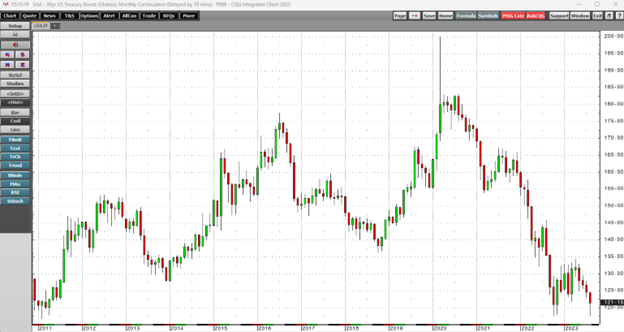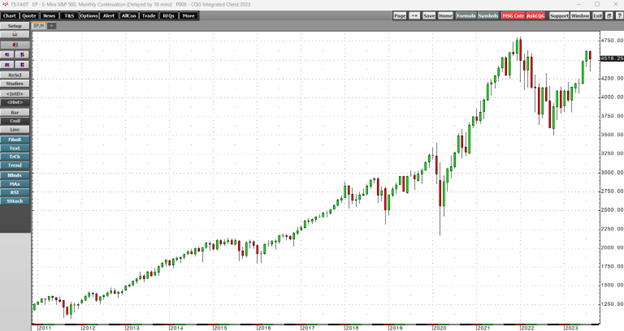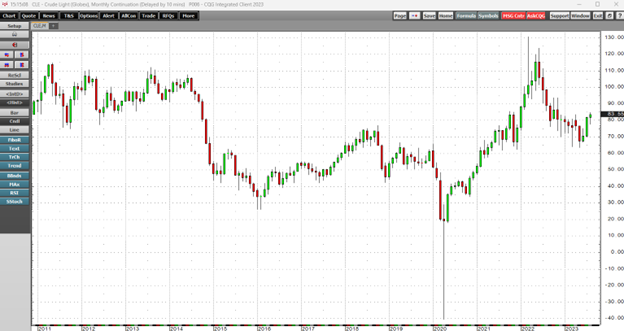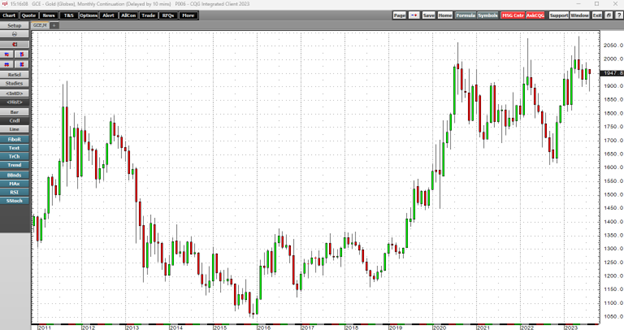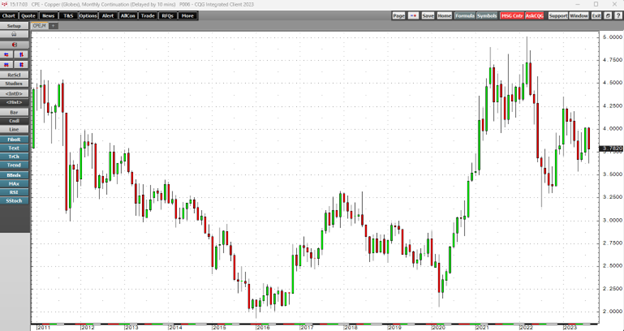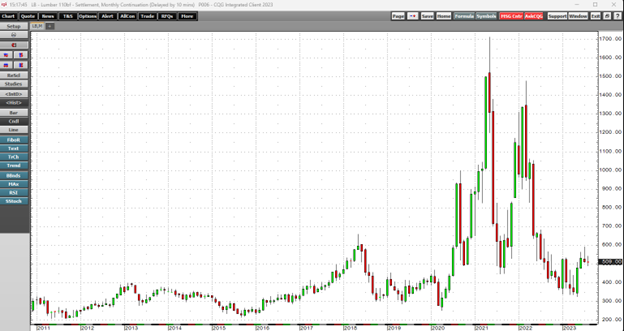Stocks compete with bonds for capital flows, and rising rates tend to weigh on the stock market. Meanwhile, high interest rates increase the cost of carrying commodity inventories, which tends to be bearish for raw material prices.
A rising interest rate environment tends to be bearish for other competing assets as higher fixed income returns attract capital to the bond market. However, September 2023 is no ordinary historical period. Markets reflect the economic and geopolitical landscapes, which remain a mess in fall 2023. Therefore, stable to higher rates over the coming months may impact markets across all asset classes differently. Historical price action suggests that the current rate environment will have bearish consequences, but many other factors could lead to surprises for market participants expecting history to repeat.
Rates have increased dramatically since March 2022
The U.S. Federal Reserve ignited liftoff from a zero percent Fed Funds Rate in March 2022. At the end of August 2023, the short-term rate stands at a midpoint of 5.375%.
The chart of the 30-year long bond U.S. Treasury futures shows the decline from 157-25 in March 2022 to the 121-18 level on August 31, 2023.
Rising interest rates have increased credit card, car, and other loan expenses. Meanwhile, the rising rates have caused the cost of a 30-year fixed-rate conventional mortgage to rise from below 3% in late 2021 to over 7.5%. A $400,000 mortgage loan now costs $1,500 more monthly, excluding many home buyers from the market.
The Fed remains committed to hawkish monetary policy
The Fed's annual summer gathering at Jackson Hole, Wyoming, sets the stage for monetary policy for the coming months. In his August 25 speech, Chairman Powell said while the FOMC will be data-dependent, inflation remains elevated, leading to a continuation of hawkish monetary policy.
While the consumer and producer price index data has decreased, inflation remains over double the central bank's 2% target level. A strong labor market and economic growth could lead to one or two more 25 basis point rate hikes before the end of 2023, pushing the Fed Funds Rate near the 6% level.
The bottom line is the Fed remains committed to battling inflation with higher rates. At best, rates will remain stable even though the previous monetary policy actions have a lagged impact as they filter through the economy.
The four reasons to expect high rates
Hopes for rate cuts disappeared at Jackson Hole, as the Fed is committed to fighting inflation. At least four factors tell us that rates will remain high for the foreseeable future:
- The U.S. dollar's role will decline - The bifurcation of the world's nuclear powers has caused the BRICS countries to move toward introducing a currency to challenge the U.S. dollar. Sanctions on Russia and other governments have caused the BRICS and their allies to consider using a gold-backed foreign exchange instrument for cross-border payments, with immunity to U.S. and European sanctions. The dollar is the world's reserve currency, but a BRICS foreign exchange instrument would cause the dollar's role in the worldwide financial system to decline. A dollar decline may cause rates to remain high to attract investment and reserve holdings in the U.S. currency.
- Inflation at 2% could be unattainable - The ongoing war in Ukraine and the bifurcation of the world's nuclear powers significantly impact on the worldwide flow of raw materials. Russia has used energy and food commodities as economic weapons against countries supporting Ukraine, pushing prices higher. Achieving a 2% inflation rate could be more than challenging in the current environment.
- The U.S. economy remains robust - U.S. employment and other economic data remain strong as we head into the final four months of 2023. The Atlanta Fed recently revised its U.S. GDP third-quarter growth forecast to 5.9%.
- The deficit will reduce foreign demand for U.S. government debt securities - The U.S. national debt at $32.7 trillion with a Fed Funds Rate of 5.375% means that even if U.S. government receipts and expenses are balanced, debt servicing will cause it to rise by more than $1.75 trillion annually. Fitch, a rating agency, recently downgraded the U.S. government's credit rating from AAA to AA+. A falling credit rating causes higher rates as risk increases. Governments buying U.S. government debt, including Japan and China, will demand higher rates to buy U.S. government debt securities. In 2023, Japan and China owned over 50% of the U.S. government debt.
While the Fed is committed to its inflation fight using short-term monetary policy, the other factors will likely keep U.S. rates higher along the yield curve.
Stocks, commodities, and cryptos could experience unexpected price action despite the high rates
Higher rates tend to be bearish for commodity prices as they increase the cost of holding inventories. However, rising financing costs also increase production costs, putting upward pressure on prices.
Meanwhile, the sharp rise in U.S. interest rates has not prevented a 2023 stock market rally. The monthly chart of the S&P 500 E-Mini highlights the over 16% rally in the most diversified U.S. stock market index in 2023. A robust economy has supported corporate profits.
The leading commodity prices have moved mostly lower but have recovered from 2023 lows.
Nearby NYMEX crude oil futures have rallied 31.3% from the May 2023 $63.64 low to $83.55 per barrel on August 31.
Nearby COMEX gold futures have recovered 7.7% from $1808.80 in February 2023 to the $1947.80 per ounce level on August 31, 2023.
Nearby COMEX copper futures prices have moved 6.8% from the May 2023 $3.54 per pound low to $3.7820 at the end of August.
Physical lumber futures prices reached a $352.50 per 1,000 board feet low in January 2023. At $509 on August 31, lumber was 44.4% higher. Lumber may be the most illiquid of the leading commodities but is the primary ingredient in new home building. Lumber prices have moved significantly higher from the low despite the rising mortgage rates.
While rates continue to rise, commodity prices have stabilized and moved higher from the 2023 lows.
Expect the unexpected in markets over the coming weeks and months
Markets reflect the economic and political landscapes, and we live in a very uncertain world in September 2023. War in Europe, friction between the world's growing number of nuclear powers, high inflation, and domestic political division in the world's leading economy can cause distortions in asset prices over the coming weeks, months, and years.
The conventional wisdom says that high interest rates will weigh on non-bond asset prices, but there is nothing conventional about the current historical period. Rates will likely remain high for the foreseeable future. Still, market participants should expect the unexpected in markets across all asset classes, as historical relationships may not repeat themselves in the current environment.
Given the current landscape, risk-reward dynamics and discipline are critical for success in markets
